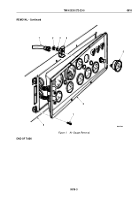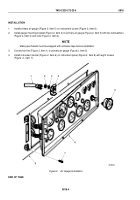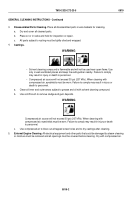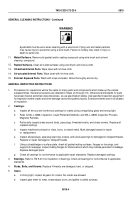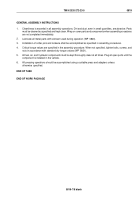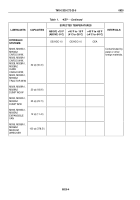TM-9-2320-272-23-5 - Page 403 of 623
GENERAL REPAIR INSTRUCTIONS - Continued
3.
Bearings.
Refer to TM 9-214.
4.
Studs.
Replace all bent and stretched studs. Repair minor thread damage with a thread die. Replace studs
having stripped or damaged threads as outlined below:
a.
Remove studs using a stud remover. Back studs out slowly to avoid heat buildup and seizure which can
cause stud to break off.
NOTE
If welding method is used, refer to TM 9-237 for proper instructions.
b.
If studs break off too short to use a stud remover or a stud extractor, use welding method.
c.
Broken studs can be removed by welding bar stock or a nut to stud and removing with wrench.
d.
Standard studs may have a coarse thread on one end and a fine thread on the other end. The coarse
thread end is installed in aluminum casting. Studs having coarse threads on both ends are used in some
applications. The shorter threaded end goes into the casting.
e.
Replacement studs have a special coating and must have a small amount of antiseize compound applied
on the threads before stud is installed. Install replacement stud slowly to prevent heat buildup and
snapping off.
5.
Gears.
a.
Remove gears using pullers.
b.
Use the same method described in Step (2) for castings to remove minor nicks, burrs, or scratches on
gear teeth.
c.
If keyways are worn or enlarged, replace gear.
6.
Bushings and Bushing-Type Bearings.
When bushings and bushing-type bearings seize to a shaft and spin
in the bore, the associated part must also be replaced.
7.
Oil Seals.
a.
Using proper oil seal removal tool, remove oil seals without damaging casting or adapter bore.
b.
Always install new seal in bore using proper seal replacement tool.
8.
Rivets.
Replace rivets in accordance with TM 9-450.
GENERAL DISASSEMBLY INSTRUCTIONS
1.
The work area for disassembly of any item must be kept as clean as possible. This will prevent contamination
of internal parts. This is especially true when working with fuel and air systems or CTIS components.
2.
All gaskets, o-rings, and seals removed during repair will be discarded and replaced with new parts. These
items are usually damaged during removal. Lockwire, lockwashers, cotter pins, and like items should be
discarded during disassembly.
3.
When removing gaskets, preformed packings, or seals, do not use any metal tools that will scratch the sealing
surfaces next to these items.
4.
Before disassembling any item, study the illustration carefully, noting the relationship of internal parts. Knowing
the details of construction will speed up disassembly and help avoid mistakes.
TM 9-2320-272-23-5
0819
0819-6
Back to Top


